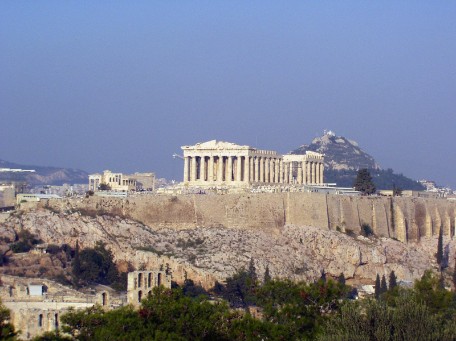
The Acropolis of Athens, also known as the Cecropia, has been inhabited since the Neolithic period, around 4000 B. C. It was fortified in the 1200s B. C. and became the center of a Mycenaean kingdom. It became sacred in the 700s B. C. when the cult of Athena Polias was established. It flourished under Peisistratos in the mid 500s B. C. when the Panathinaia was established and the first monuments at the Acropolis were built, including the "Old temple" and the Hekatompedos (the ancestor of the Parthenon), both of which were dedicated to Athena. A shrine to Artemis Brauronia and the first monu mental propylon were also built at this time. Many votive offerings, including mar ble korai and horsemen and bronze/terracotta statues were dedicated to the sanctuary. Several of them have inscriptions that show how important the cult of Athena was.
In the middle of the 400s B. C., when Athens became the seat of power in the Athenian League and Athens was the greatest cultural center, the statesman Pericles start ed an ambitious building project. which lasted for the second half of the century. Atheni ans and foreigners all worked on this project, receiving one drachma a day. The Parthenon, Propylaia, Erectheion, and the temple of Athena Nike were all built by Peri cles. The northern part of the Acropolis was used for the earlier temples and shrines to other Olympian gods, and the southern part was used for Athena in her many forms: Po lias, Parthenos, Pallas, Promachos, Ergane, and Nike. From the end of the Peloponnesian War in 404 B. C. to the 100s B. C., no more important buildings were built.
In 27 B. C., a temple dedicated to Augustus Caesar and Rome was built east of the Parthenon. The Acropolis kept its sanctity and prestige during Roman times and still gained votive offerings from pilgrims. After the Herulians invaded in the 200s, a new wall with two gates was built on the western side. The Parthenon, sadly would suffer from time and man. The temples would be converted into Christian churches after the rise of Christianity, The Parthenon was dedicated to the Virgin Mary (Parthenos Maria) and was renamed Panagia Athiniotissa and turned into a cathedral in the 1000s. The Erechtion became dedicated to the Saviour (Sotiros or Panagia), The temple of Athena Nike became a chapel, and the Propylaia was used as an episcopal residence. From 1204 - 1456 the French used it as a residence for the King and the Ottomans kept a garrison there from 1456 - 1833. The Venetians destroyed the Parthenon, then being used as a munitions store, on September 26, 1687. Thomas Bruce, Seventh Earl of Elgin, looted the sculp tures from the Parthenon from 1801 - 1802. In 1822, the Acropolis was finally regained by the Greeks.
Investigations were made at the Acropolis in 1835 and 1837, and from 1885 - 1890 Panagiotis Kavvadias conducted a systematic excavation. Nicolaos Balanos con ducted the first large-scale restoration project in the early 1900s. In 1975, the Committee for the Conservation of the Monuments on the Acropolis was founded and began a large-scale conservation and restoration of the Acropolis. The restoration continues today and the Acropolis is considered the one place every visitor to Athens should see.
There has been some debate between the Greek and British governments over the Elgin Marbles, which has still not been resolved. The Greek side is that the Marbles are Greek, a precedent has been set by other museums to return the Marbles, a museum has been built in order to protect the Marbles, and the Marbles were obtained illegally. The British state that they are creating a world-spanning cultural collection, the precedent this would set would empty most museums, the Marbles would be destroyed by the environ ment in Athens, the collection will never be complete anyway, and the museum is banned by charter to return any part of its collection.